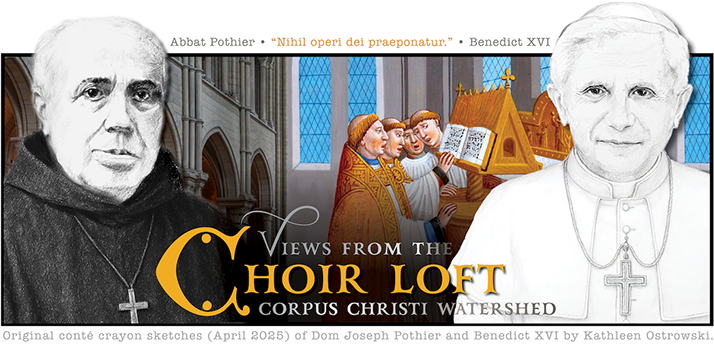The encounter with the beautiful can become the wound of the arrow that strikes the heart and in this way opens our eyes, so that later, from this experience, we take the criteria for judgment and can correctly evaluate the arguments. For me an unforgettable experience was the Bach concert that Leonard Bernstein conducted in Munich after the sudden death of Karl Richter. I was sitting next to the Lutheran Bishop Hanselmann. When the last note of one of the great Thomas-Kantor-Cantatas triumphantly faded away, we looked at each other spontaneously and right then we said: “Anyone who has heard this, knows that the faith is true.” —Josef Cardinal Ratzinger (August 2002)
 ECENTLY, PLAYING a prelude before a Mass, I thought of the preeminence of beauty in our faith. In no other religion is beauty given such a special importance. Sometimes when we walk through a museum or listen to beautiful music in worship it can be so easily assimilated and almost discarded. We can tend to forget what work, effort and suffering goes into the creation of something beautiful.
ECENTLY, PLAYING a prelude before a Mass, I thought of the preeminence of beauty in our faith. In no other religion is beauty given such a special importance. Sometimes when we walk through a museum or listen to beautiful music in worship it can be so easily assimilated and almost discarded. We can tend to forget what work, effort and suffering goes into the creation of something beautiful.
Another statement of Pope Emeritus Benedict comes to mind:
“…Be fully conscious of your great responsibility to communicate beauty, to communicate in and through beauty!”
Special awareness or sensitivity: awareness of something for what it is; internal knowledge: being awake, aware. To be conscious is to be living and to practice mindfulness. Mindfulness is kind of a new thing that we hear about. But it’s not really a fad, inasmuch as those who are fully awake in life will be mindful of beauty. And surely, those close to God are most conscious of beauty.

So, sitting at the console, I played a “Tierce en Taille” by De Grigny. Just think (be conscious and mindful) of what layers of people effort and work it took to make my little offering possible. We could begin with DeGrigny: (baptized September 8, 1672 – November 30, 1703) one of the greatest of composers for the organ, died prematurely in 1703, aged 31, shortly after accepting a position from Saint Symphorien, the parish church in Reims. This great loss can be so regretted, but we can rejoice that we have still his Livre d’orgue, which is the only surviving record of his great creativity. There are only a few surviving copies of this book, and there is only one copy remaining of the first edition. So, next we need to be grateful for those anonymous people who loved the beauty of this music and somehow preserved it form war, pestilence an ignorance. One of those people who preserved a copy was J. S. Bach.
Where to next? We can certainly mention the great French organ builders of his day, who built instruments painstakingly by hand. The many people who hammered the metal, sawed the wood and voiced the pipes. Those builders who created a sound so rhetorically strong that deGrigny was inspired to write his Tierce en Taille, a beautiful declaration given out on the cornet stops in the left hand, and particular lovely registration, which was the result of a very long historical development in itself.
We could mention that deGrigny was born into a family of musicians: his father, his grandfather, and his uncle, Robert, were organists at the Reims Cathedral, the Basilica of St. Pierre and St. Hilaire, respectively…So based on the exquisite quality of his music, he must have had extensive training, as was schooled in the art of French organ playing by his relatives, who in turn were taught by others—all who had a heart to receive beauty.
We can continue…we can note those musicians all through the generations that kept alive the idea of worthy music in the church, who continued the tradition of organ playing, so that, coming all the way to my teacher, understood the craft and art of playing the organ—it has never been lost, thanks to a long line of teachers. We could mention the chapel where the organ is—the many donors, architects builders and supporters who conceived of the idea of this chapel as a place for the Eucharist and did what was needed to create a reality. We could mention the organ—beautifully voiced like the old instruments—forming a historical connection again, all the people who designed it (the brilliant organ builder Ross King) those who built it, tuned and voiced it…

And last, Humbly standing on the many shoulders of others, those who taught me how to play the organ, were patient with me when I didn’t practice (too often!) and imparted an appreciation of this music and why it is so fitting for sacred worship. All this just to make my little offering possible!
Let us be conscious of beauty.

